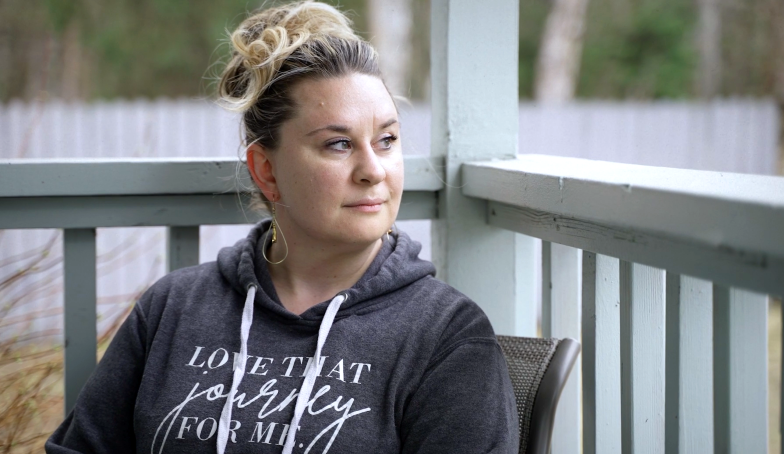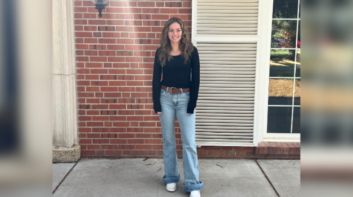On a small, unassuming cul-de-sac in Alaska, the mother of two young daughters came face-to-face with the growing phenomenon of adolescent girls identifying as the opposite sex due to a social desire to appear transgender. Critics call the social contagion theory “unfounded” and “absurd.” But for Susie, whose name I’ve changed to protect her family’s privacy, she watched it unfold in her own neighborhood, inside her own home.
After returning in 2020 to the U.S. from a four-year assignment abroad, Susie’s family settled into a house on a street where two out of the eight girls identified as boys. At the local high school where their daughter would soon attend, at least another 10 girls identified as the opposite sex. Shortly after moving there, Susie’s oldest daughter, who had just turned 15-years-old, also said she felt like a boy.
Susie’s daughter was still wearing skirts and makeup. Growing up, she never had ‘tomboy’ tendencies or showed signs of gender confusion. Susie didn’t believe that her daughter’s sudden transgender identity was anything more than a phase, so she and her husband chose not to make any drastic changes, settling on a “wait and see” approach. They wanted to give their daughter time to experience and explore her feelings, without giving into the lie that their daughter was anything but her biological sex.
But every institution surrounding them, from health professionals, to the public school, and a local LGBT support group, rushed to validate their daughter’s gender confusion, treating it as real. Worse, they intentionally deceived Susie and her husband, using their daughter’s birth name and female pronouns in official communications, while using her made-up name and male pronouns behind closed doors.
As a new school year commences, the situation is still ongoing. Susie’s daughter tells her mom that she’s still confused about her gender, but the school sees no nuance in that confusion. Instead, school officials affirm her feelings as a boy, against Susie and her husband’s objections.
One of the first things Susie and her husband did after their daughter said she was transgender was find a therapist who they thought could explore why her daughter felt like a boy. The therapist introduced Susie’s daughter to a local online community of children who also identified as transgender, which Susie thought might help. By meeting people whose gender identity had been a struggle since early childhood, Susie thought her daughter might realize what she was experiencing was different. But that’s when Susie realized that all the children identifying as transgender were just like her daughter.
“They were all 12 and up. And it was all recent,” Susie said.
The group was supposed to be monitored by an adult who was affiliated with a local LGBT group. But when the conversation veered into a discussion about the leather pride flag, which indicates an interest in kink, it became clear that it lacked adult oversight.
“That’s totally inappropriate,” Susie said. “He, or whoever it was, was not moderating the conversation or taking into account that these kids are barely in middle school.”
After participating in the group, Susie said attempts to talk to her daughter about her gender confusion went from open and productive to hostile. Using new buzzwords she picked up, such as “dead name,” which refers to a birth name a person who identifies as transgender no longer uses, her daughter would lash out and instigate fights that never used to occur in their home.
Sensing their daughter’s mental health was declining, Susie and her husband decided to sit in on a session with the therapist. During that session, they learned the therapist had been using male pronouns and her daughter’s made-up name from their very first meeting. This had been going on for about six weeks, and Susie and her husband had no idea.
Susie and her husband tried to explain to the therapist why they needed time to process their daughter’s feelings and weren’t ready to implement changes such as using male pronouns or her new made-up name. For starters, it was the first time Susie’s daughter had vocalized these feelings face-to-face with her father. Prior to that, she had only confided in her mother. But instead of listening or asking her daughter questions, Susie said the therapist turned on her and her husband, pitting them against their daughter by suggesting their support was insufficient and offering to “talk to the school” on their daughter’s behalf.
“My jaw hit the floor,” Susie said. “We love our daughter so much and we would never disown her or abandon her for any reason. There’s nothing on this planet that could make us do that. Then to have someone step in and treat us like we aren’t doing what’s good for her when they have known her for two months — we’ve known her for her whole life.”
Susie’s daughter lived a happy, healthy childhood until the sixth grade, when she made friends with a girl while living abroad who was self-harming. After that, Susie said her daughter also began self-harming, though superficially, which prompted Susie to seek therapy for her daughter. A year and a half before they moved back to the U.S., a child psychologist diagnosed Susie’s daughter with anxiety, depression, and “failure to adapt.”
After her daughter began identifying as a boy, Susie e-mailed the therapist from overseas to ask if, during their 18 months together, the issue of gender identity had ever come up. The therapist told Susie that her daughter “did not meet any of the criteria or give any indication [that being transgender] was a genuine thing for her,” Susie said. The therapist was “99% certain that this was a phase.”
The therapist recommended that Susie and her husband continue the “wait and see” approach they were currently pursuing, which meant showing love and consistency while setting healthy boundaries for their daughter.
Susie and her husband stopped booking sessions with their daughter’s new therapist in Alaska and to Susie’s knowledge, that therapist never contacted the school. But unbeknownst to them, the school was already transitioning their daughter behind their backs.
Shortly after classrooms reopened for in-person learning in the spring of 2021, Susie’s daughter had an anxiety attack at school. Susie suggested that she visit with the school counselor, whom she had told about her daughter’s gender exploration, and how she and her husband wished to handle it.
“At the time I thought the counselor was indicating to me that she understood and agreed with what I was saying,” Susie said.
But in fall 2021, at the start of the next school year, Susie found her daughter’s school ID, which featured her new, made-up name.
The fact that the school was transitioning her daughter behind her back came as a surprise to Susie, since the school was still communicating with her using female pronouns and her daughter’s birth name. To avoid upsetting her daughter, Susie waited to confront the school. But that winter, Susie decided to email the counselor asking how her daughter’s name would appear in the yearbook. Susie was told she would receive an email from the faculty member in charge of the yearbook. But instead, she received a phone call from the school counselor and the curriculum advisor.
“They proceeded to tell me, I have no say over anything my daughter wants to go by or what’s in her record or anything,” Susie said. “The only thing I had a say over was what her name was on her transcript. And the only way that changes is with a court-documented name change. But otherwise, their wording to me was that it was illegal for me to insist on a certain name or anything in the yearbook or on her ID.”
Susie was at work when she received the call. She followed up with an email asking for the legal basis for the school’s actions. They told her their legal reasoning was based in Title IX.
Title IX is a federal statute that outlaws sex discrimination in education. The Biden administration recently proposed new rules that expand the law to cover “gender” and “gender identity,” giving schools an excuse for socially transitioning children while keeping parents in the dark. While the Biden administration certainly intends to push these controversial and potentially illegal rule changes, those rules are not yet in effect and schools are currently free to respect parental rights.
“The fact that they were using guidelines to fight me kind of caught me off guard,” Susie said. “I had to educate myself.”
A couple of weeks later, Susie had a follow-up conversation with a representative from the school district. She explained how her daughter’s former therapist, whom she had worked with for 18 months, didn’t think her daughter’s transgender identity was genuine. She asked why the school was refusing to get on board with the approach she and her husband wanted to take.
The district representative told Susie they don’t need a diagnosis to call her daughter whatever she wants to be called. When pressed to explain how they differentiate between what is a casual declaration and a mature, well thought out decision, the representative told Susie, “They watch the child.”
Susie was never told who was watching her child. She was simply told, “They observe them and see how they dress and what type of activities they participate in.”
At the time, Susie’s daughter still wore skirts and makeup.
With a new school year beginning this month, Susie logged into the parent portal to check her daughter’s information. The name she filled out when enrolling her daughter was changed, then grayed out with no ability for her to edit.
“Obviously, someone who isn’t her parent or legal guardian entered this on her enrollment paperwork,” Susie said. “How do you stop the school from doing something that they’re not telling you that they’re doing?”
Susie hasn’t been able to find a new therapist whom she can trust, and feels betrayed by her local public school.
“I thought parents and the school were supposed to work together for the well-being of the child,” Susie said. “It doesn’t feel like that’s happening.”
Susie feels alone and, in many ways, abandoned in how she’s attempted to navigate her daughter’s gender confusion. But in her community, she’s far from alone in having a child who identifies as transgender.
“My daughter’s friend group at school, everyone is something. No one is themselves, for lack of better words. Everyone’s a different gender,” Susie said, adding:
“Girls going through stuff collectively in high school and middle school together, and influencing each other is nothing new. Every girl has been through it, but I think what makes this different is that it is becoming a human rights issue and it’s being taken on by adults that don’t necessarily play a part in a child’s life. And it’s being championed by people who don’t have children or don’t have children dealing with it. I feel like if I were to start using the preferred name and pronouns, I feel like that’s kind of the nail in the coffin. That’s me saying, ‘Yes, there is something not right about you as a female. So you should definitely identify as a male because you don’t act the way a female should act.’ And I would never want to put that thought in her head. And frankly, it makes me sad that she has that thought in her head to begin with — and that it’s being fed by the school and that former therapist.”
Susie’s now-16-year-old daughter recently said that going to school makes her “want to throw up with anxiety.” Often she asks not to go to school at all. Right now, Susie said the school is the only place that’s using male pronouns and her daughter’s made-up name.
“If she’s trying to get away from school because it makes her feel bad, and she wants to be home where we absolutely affirm her as a person, but we don’t affirm this identity, to me, that speaks volumes,” Susie said. “Her safe place is where we’re letting her be herself.”










